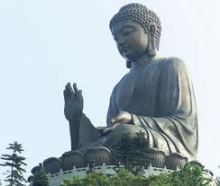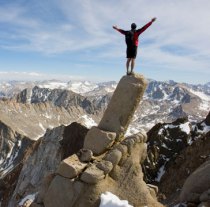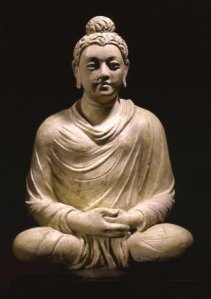Last Quarter Moon, Uposatha, May 13, 2012
The Triple Gem in American Folk Buddhism
 Refuge in the Triple Gem, the Buddha, the Dharma and the Sangha, is in the intersection of Essential and Folk Buddhism. In fact it is what makes Folk Buddhism Buddhism. Repeatedly in the Suttas the newly convinced becomes a disciple of the Buddha by taking refuge in the Buddha, the Dharma and the Sangha. The Buddha, the Dharma and the Sangha nourish the entire practice of Buddhism and at the same time anchors Folk Buddhism in Essential Buddhism by weeding out or adapting those elements of Folk Buddhism that are inimical to Essential Buddhism. Refuge in the Triple Gem is to place faith or trust in the authority of Essential Buddhism by accepting the authority of its three representatives.
Refuge in the Triple Gem, the Buddha, the Dharma and the Sangha, is in the intersection of Essential and Folk Buddhism. In fact it is what makes Folk Buddhism Buddhism. Repeatedly in the Suttas the newly convinced becomes a disciple of the Buddha by taking refuge in the Buddha, the Dharma and the Sangha. The Buddha, the Dharma and the Sangha nourish the entire practice of Buddhism and at the same time anchors Folk Buddhism in Essential Buddhism by weeding out or adapting those elements of Folk Buddhism that are inimical to Essential Buddhism. Refuge in the Triple Gem is to place faith or trust in the authority of Essential Buddhism by accepting the authority of its three representatives.
At the time an American first enters the Buddha way she will likely have found something that has impressed her, perhaps the story of the Buddha’s life, perhaps the first encounter with the Buddha’s teachings, perhaps an encounter with someone who is a worthy product of Buddhist practice and understanding, perhaps all three. She will still understand little about just what Buddhism is for that gets very complicated, nor will she have ventured far into Buddhist practice for it is a long path. Much of her familiarity with Buddhism will likely have been gained largely through folk influences or through her own culturally based assumptions. She has probably read popular literature rather than delving into the particulars of Buddhist Studies. That is all fine.
 But she has decided that wants to go further into Buddhism and is potentially on a steep learning curve. By taking refuge in the Buddha, the Dharma and the Sangha she opens her mind to the guidance of the corrective, instructive, exemplary and inpirational influences of Essential Buddhism and expresses a willingness to give up false understandings acquired through less reputable sources as she learns that some do not accord with Essential Buddhism. This is analogous to trusting the results of scholarly research more than urban legend, neighborly hearsay or the opinions of TV pundits. It is also analogous to hanging a picture of Gandhi on her wall to keep the principles and values he represents steadfast in mind while negotiating all of the unsavory influences in the world around her.
But she has decided that wants to go further into Buddhism and is potentially on a steep learning curve. By taking refuge in the Buddha, the Dharma and the Sangha she opens her mind to the guidance of the corrective, instructive, exemplary and inpirational influences of Essential Buddhism and expresses a willingness to give up false understandings acquired through less reputable sources as she learns that some do not accord with Essential Buddhism. This is analogous to trusting the results of scholarly research more than urban legend, neighborly hearsay or the opinions of TV pundits. It is also analogous to hanging a picture of Gandhi on her wall to keep the principles and values he represents steadfast in mind while negotiating all of the unsavory influences in the world around her.
Free Thinking. Asian Folk Buddhisms tend to embellish the Triple Gem quite a bit, often turning them from objects of reverence to objects of deep devotion and worship, often wrapping mythology around the objects, stories of supernatural forces and miracles, and in the case of the Buddha transcendent existence. These embellishments nonetheless generally remain close to the function of the Triple Gem in Essential Buddhism in that they serve to enhance the authority of Essential Buddhism, to inspire and make the mind that much more open to its influence. However this tendency toward embellishment has little currency yet in American Folk Buddhism, in fact many American Buddhists swing the other way.
A common factor in the way the Refuges are practiced and understood in American Folk Buddhism is free-thinking, captured for instance in the following quote:
 “Believe nothing, no matter where you read it, or who said it, no matter if I have said it, unless it agrees with your own reason and your own common sense.” – “The Buddha”
“Believe nothing, no matter where you read it, or who said it, no matter if I have said it, unless it agrees with your own reason and your own common sense.” – “The Buddha”
Free-thinking is related to the Protestant rejection of authority that we discussed last week, but more importantly to the post-(European-)Enlightenment regard for rational or critical thinking and the parallel disparagement of “faith,” and accounts for the popularity in the West of the quote above. This passage was however never spoken by the Buddha. I don’t know who made it up.
 Critical thinking is certainly a strength of Western culture, one that has already served Buddhism well, not so much Folk Buddhism as Essential Buddhism. We are now in a historical process of reconsidering much of what has been unquestioned in Asian Buddhism for many centuries and this is driven largely by Western or Western-influenced scholarship. For instance many texts have been attributed directly to the Buddha for centuries that modern scholarship has revealed to be of more recent origin. Traditional accounts of the history of the various Buddhist schools have likewise endured without question have been discredited. Comparisons of texts in diverse languages open up new possibilities for interpretation. The melting of a lot of frozen assumptions in the various Buddhists traditions promises to open up Buddhism is many beneficial ways. However an extreme form of free-thinking can be detrimental to Essential Buddhism.
Critical thinking is certainly a strength of Western culture, one that has already served Buddhism well, not so much Folk Buddhism as Essential Buddhism. We are now in a historical process of reconsidering much of what has been unquestioned in Asian Buddhism for many centuries and this is driven largely by Western or Western-influenced scholarship. For instance many texts have been attributed directly to the Buddha for centuries that modern scholarship has revealed to be of more recent origin. Traditional accounts of the history of the various Buddhist schools have likewise endured without question have been discredited. Comparisons of texts in diverse languages open up new possibilities for interpretation. The melting of a lot of frozen assumptions in the various Buddhists traditions promises to open up Buddhism is many beneficial ways. However an extreme form of free-thinking can be detrimental to Essential Buddhism.
Come and See. Let me invoke a couple of concrete examples to illustrate what is misguided in the free-thinking quote provided above. Briefly it suggests that even at the beginning of Buddhist practice one is already competent to apply reason and common sense usefully. The Buddhist position is that the typical uninstructed worldling is actually pretty deluded. The Buddha claimed that the Dharma goes “against the stream,” because it does not make a lot of sense to the average person. We live in a looking glass world in which what we think is forward is actually backward and right is wrong. Following the advice of the quote above cannot produce good results; in fact it is difficult to see how that is different than what one is doing before one discovers Buddhism.
 What does appeal in Buddhism to the critical thinker is the Buddha’s basic method of instruction: “Come and see!” What the Buddha taught is almost always based firmly in direct experience, it is empirical. Now, the phrase “come and see” is concise, but that does not always make it easy. First, when the Buddha says “come” he is shouting down to us from the mountaintop. To arrive at his vantage point we need to scramble up hills, struggle through brambles, ford rivers. When the Buddha says “see” we need to focus our eyes intently in the right direction to barely make out what the Buddha sees with great clarity of vision. In order to be willing to do any of this we have to start out with great faith and trust already that the Buddha knows what he is talking about. This is Refuge in the Buddha and his teachings. What else would induce us to make the difficult climb up the mountain?
What does appeal in Buddhism to the critical thinker is the Buddha’s basic method of instruction: “Come and see!” What the Buddha taught is almost always based firmly in direct experience, it is empirical. Now, the phrase “come and see” is concise, but that does not always make it easy. First, when the Buddha says “come” he is shouting down to us from the mountaintop. To arrive at his vantage point we need to scramble up hills, struggle through brambles, ford rivers. When the Buddha says “see” we need to focus our eyes intently in the right direction to barely make out what the Buddha sees with great clarity of vision. In order to be willing to do any of this we have to start out with great faith and trust already that the Buddha knows what he is talking about. This is Refuge in the Buddha and his teachings. What else would induce us to make the difficult climb up the mountain?
To take a first example, in my early days of Buddhist study I learned that craving is the origin of suffering (the Second Noble Truth). At first I thought of this as an abstract proposition, one that I would have to approach intellectual to try to match up with observation. I would have rejected it out of hand on the basis of common sense: It seemed pretty clear to me at the time that buying that snazzy shirt would make me more dashing and that that would lead to prospects for romance and be cool besides. This would be how craving leads to happiness not suffering, a clear counterexample. Yet instead I trusted the Buddha.
 Through much reflection and a lot of meditation it was still some time before I saw what the Buddha was getting at,: The Second Noble Truth is not an abstraction at all; it is something that can be observed directly over and over. As soon as the craving comes up the suffering is right there with it. As soon as I “had” to have that shirt, there was stress and anxiety. But as soon as I backed up a bit with the thought, “I don’t really need that,” the suffering vanished. I realized I had been living in a world of incessant suffering, a world that was aflame, and I had not even noticed with all my vast reason and common sense. Arriving at what the Buddha was getting at was a matter of scrambling, struggling and fording to reach the mountaintop, but once I got there, reality spread out before me.
Through much reflection and a lot of meditation it was still some time before I saw what the Buddha was getting at,: The Second Noble Truth is not an abstraction at all; it is something that can be observed directly over and over. As soon as the craving comes up the suffering is right there with it. As soon as I “had” to have that shirt, there was stress and anxiety. But as soon as I backed up a bit with the thought, “I don’t really need that,” the suffering vanished. I realized I had been living in a world of incessant suffering, a world that was aflame, and I had not even noticed with all my vast reason and common sense. Arriving at what the Buddha was getting at was a matter of scrambling, struggling and fording to reach the mountaintop, but once I got there, reality spread out before me.
I would not have gotten there without faith in the Buddha and his teaching, and once I did get there that faith grew greater. Similarly, Shohaku Okumura has said of Zen meditation, “It takes a lot of faith to do zazen. Otherwise nobody would do something so stupid.” From the perspective of the uninstructed worldling, for the person simply applying reasoning and common sense, it will appear stupid. Most of Essential Buddhism will appear stupid.
 The second example involves my role as a Buddhist teacher. A couple of years ago I was in ongoing dialog with a young man concerning matters Buddhistes. I observed that he was habitually and very vocally critical of almost every one around him, and that he even pried into private matters in order to expand the scope of his criticism with an almost missionary zeal. I could see that this was not a wholesome project on many different levels so I decided to call him on it. I recommended that for one year he try not to criticize anyone, that when a critical thought arises he simply let it go and by no means express it verbally. Then after a year he could tell me what he had learned. This would be pure “come and see.” He refused to do it! Not only that, he mustered an array of reasons that to his common sense convinced him that he should continue his worthy project. “If people don’t correct things how are things ever going to get better?” and so on. I have a developed rational faculty myself so I tried to argue with him for a bit, but on reflection I could not recall anyone ever convincing someone else of anything through rational argument that they did not already want to believe, except maybe occasionally in academic circles, so I did not pursue this further. Here I was, standing maybe not on a mountaintop but at least on a hilltop, inviting him to come and see what I could see, and there he was standing below among the bushes and trees telling me he could see perfectly well. This is what happens when someone does not take refuge in the Sangha. I realized that this was a person not yet ready for Buddhist practice, and that there was nothing I could do to help.
The second example involves my role as a Buddhist teacher. A couple of years ago I was in ongoing dialog with a young man concerning matters Buddhistes. I observed that he was habitually and very vocally critical of almost every one around him, and that he even pried into private matters in order to expand the scope of his criticism with an almost missionary zeal. I could see that this was not a wholesome project on many different levels so I decided to call him on it. I recommended that for one year he try not to criticize anyone, that when a critical thought arises he simply let it go and by no means express it verbally. Then after a year he could tell me what he had learned. This would be pure “come and see.” He refused to do it! Not only that, he mustered an array of reasons that to his common sense convinced him that he should continue his worthy project. “If people don’t correct things how are things ever going to get better?” and so on. I have a developed rational faculty myself so I tried to argue with him for a bit, but on reflection I could not recall anyone ever convincing someone else of anything through rational argument that they did not already want to believe, except maybe occasionally in academic circles, so I did not pursue this further. Here I was, standing maybe not on a mountaintop but at least on a hilltop, inviting him to come and see what I could see, and there he was standing below among the bushes and trees telling me he could see perfectly well. This is what happens when someone does not take refuge in the Sangha. I realized that this was a person not yet ready for Buddhist practice, and that there was nothing I could do to help.
 Faith in Buddhism. What really frightens the critical thinker is blind faith, faith for which he is given no way to come out the other side. The Buddha had a lot to say about faith and as the Kalama Sutta tells us, he did not have much regard for blind faith, nor for what is arrived at by reason or common sense for that matter. He did however admonish his disciples to listen to the wise, those who can see further than they. The Buddha saw faith essentially as provisional, a way to arrive at seeing and knowing, something you eventually come out the other side of. Coming takes faith, seeing convinces one that one’s faith was well placed.
Faith in Buddhism. What really frightens the critical thinker is blind faith, faith for which he is given no way to come out the other side. The Buddha had a lot to say about faith and as the Kalama Sutta tells us, he did not have much regard for blind faith, nor for what is arrived at by reason or common sense for that matter. He did however admonish his disciples to listen to the wise, those who can see further than they. The Buddha saw faith essentially as provisional, a way to arrive at seeing and knowing, something you eventually come out the other side of. Coming takes faith, seeing convinces one that one’s faith was well placed.
Faith is the indispensable bold part of human cognition. We live in a world of great uncertainty, yet we know we must act and that our actions will have real consequences. Faith is what bridges or leaps over the gap between what we know and what we really need to know to gain confidence in our actions. I’ve already written a series on faith (click here), so I will not elaborate here.
Blind faith exists in Buddhism, however it is not by design. It exists out of laziness, because over time many assumptions can go unexamined when people learn them at an uncritically young age generation after generation for many centuries. This has clearly happened repeatedly in Asia, though there have been occasional reformation movements to clear up the sludge. This is where critical thinking can play a crucial role as Westerners look at Essential Buddhism with fresh eyes.
 The basis of Buddhist faith, the basis of all of Buddhism, is the Triple Gem. It is faith that the three representatives of Essential Buddhism know what they are talking about. Unless you place faith in your doctor or acupuncturist you cannot be healed. Unless you place faith in the Buddha, the Dhamma and the Sangha you will not experience what Buddhism is all about and will not realize its benefits. It is at first jumping into the unknown … but you come out the other side to inspire others, “Jump in! The water’s fine.”
The basis of Buddhist faith, the basis of all of Buddhism, is the Triple Gem. It is faith that the three representatives of Essential Buddhism know what they are talking about. Unless you place faith in your doctor or acupuncturist you cannot be healed. Unless you place faith in the Buddha, the Dhamma and the Sangha you will not experience what Buddhism is all about and will not realize its benefits. It is at first jumping into the unknown … but you come out the other side to inspire others, “Jump in! The water’s fine.”
Finding the Triple Gem. So, where are these three objects of faith, trust and reverence to be found? Because we have such a daunting plethora of Buddhist traditions in America, and because the monastic tradition is almost entirely absent, these are not trivial questions.
 The Buddha was a real person who lived some hundred generations ago, attained some remarkable qualities including Awakening and was able to formulate a path by which others could attain those qualities. He has been represented symbolically for us for perhaps ninety-two generations through statuary to provide a more emotionally satisfying and present object of reverence. However, there are some schools of Buddhism that substitute other figures, such as the mythical Amitabha Buddha for the historical Buddha. Nonetheless functionally the substitute plays a similar role, since the substitute is assumed to have those same remarkable qualities. Sometimes a highly regarded teacher, such as Dogen or Tsong Kha Pa, assumed to have acquired similar qualities assumes some of the role of the first Gem.
The Buddha was a real person who lived some hundred generations ago, attained some remarkable qualities including Awakening and was able to formulate a path by which others could attain those qualities. He has been represented symbolically for us for perhaps ninety-two generations through statuary to provide a more emotionally satisfying and present object of reverence. However, there are some schools of Buddhism that substitute other figures, such as the mythical Amitabha Buddha for the historical Buddha. Nonetheless functionally the substitute plays a similar role, since the substitute is assumed to have those same remarkable qualities. Sometimes a highly regarded teacher, such as Dogen or Tsong Kha Pa, assumed to have acquired similar qualities assumes some of the role of the first Gem.
The Dharma is the teachings of the Buddha. This is certainly most literally represented by the ancient Suttas or Agamas. These are made tangible through recitation and chanting. However there are many schools of Buddhism and almost every one assumes a distinct scriptural basis. Sometimes the physical text becomes an object of veneration, as does a scroll of the Lotus Sutra does in the Nichiren School. My feeling is that Essential Buddhism can be discovered in most of the major schools of Buddhism, that even if they do not quote the Buddha literally or accurately, a functional equivalence to the original Buddha’s teachings is present in the scriptural foundation of most schools. I recommend that the American Buddhist interested in the investigating authenticity of a particular version of the Dharma become familiar with the Pali Suttas or the Chinese Agamas as a way of cross-checking for accurate transmission to our land.
The Sangha consists of living representatives of Essential Buddhism. Unfortunately the Sangha is difficult to find in the West and apparently as a result of this the term “Sangha” has been adjusted simply to refer to all Buddhists, Essential or Folk. This threatens to become a wedge between Folk and Essential Buddhism. Next week I would like to explore what “Sangha” means in American Folk Buddhism to complete the discussion of the Triple Gem.
May 13, 2012 at 3:18 pm |
Another great post. I think it’s important to emphasize to westerners that Buddha did not tell them to trust their own conclusions all the time — that faith in the triple gem trumps their own inclinations. But such a project is not easy in our supremely narcissistic society.
LikeLike
May 13, 2012 at 5:22 pm |
Jose [?], I know I will step on some toes with this series. But this is one of the great values of Buddhism coming to the West; it highlights the most unskillful aspects of our culture and our selves.
LikeLike
May 14, 2012 at 12:06 pm |
The second Noble Truth was easy for me to look at. All I had to do was to look at my life and what attachments had caused me to suffer. In fact the second Noble Truth was the concept to help me in a realationship breakup that freed me from most of the pain at the time. Not all, but most. As time went on it started to make sense to me. I need to devote more time to my practice not because I want to be a ” better Buddhist” but because I need to stay out of the dark the Mara which I find my self in. Thank you Venerable One for the teachings.
LikeLike
June 8, 2012 at 4:54 pm |
The buddha,dhamma and sangha are the way to lead a peaceful life
LikeLike